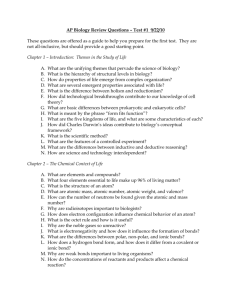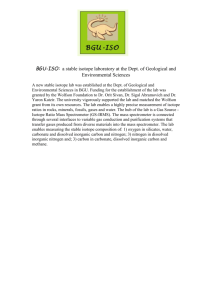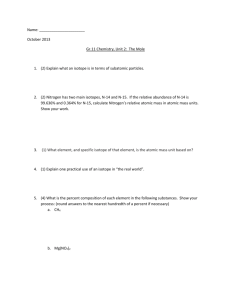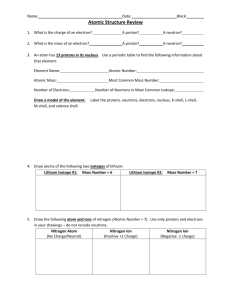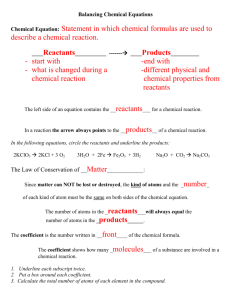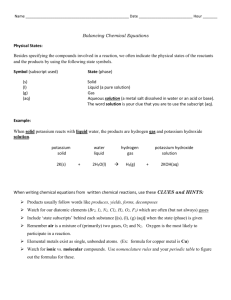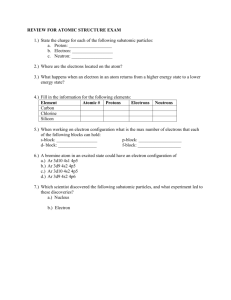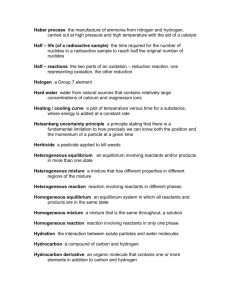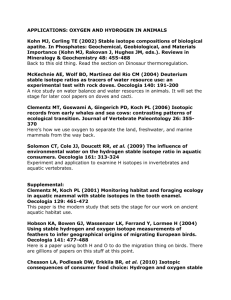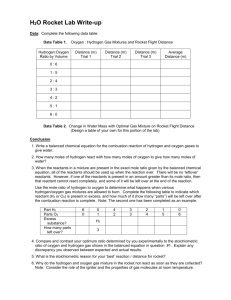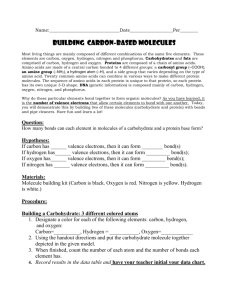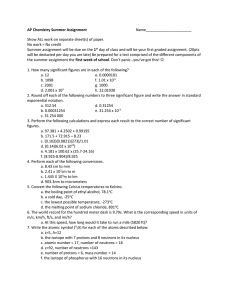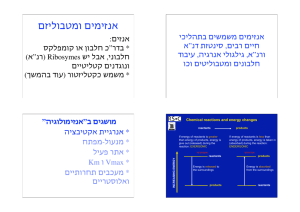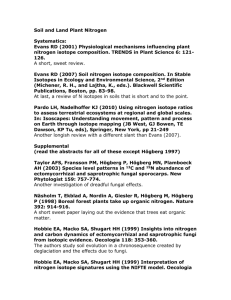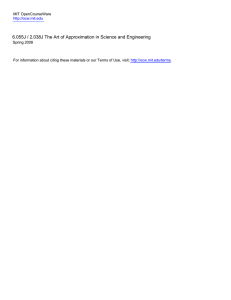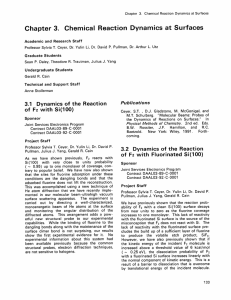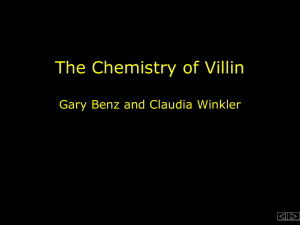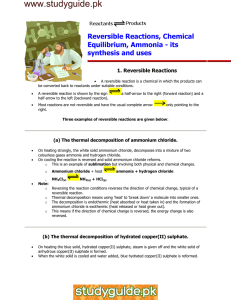Name AP Biology Summer Assignment, 2014 Chapter 2 Section 2.1
advertisement
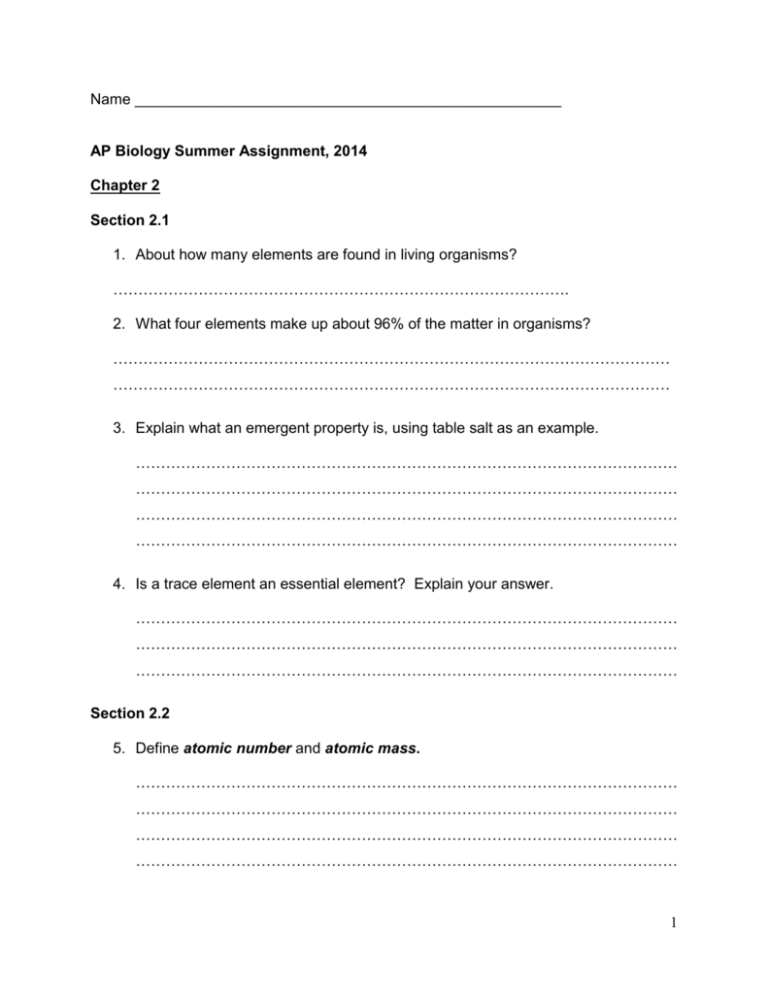
Name ___________________________________________________ AP Biology Summer Assignment, 2014 Chapter 2 Section 2.1 1. About how many elements are found in living organisms? ………………………………………………………………………………. 2. What four elements make up about 96% of the matter in organisms? ………………………………………………………………………………………………… ………………………………………………………………………………………………… 3. Explain what an emergent property is, using table salt as an example. ……………………………………………………………………………………………… ……………………………………………………………………………………………… ……………………………………………………………………………………………… ……………………………………………………………………………………………… 4. Is a trace element an essential element? Explain your answer. ……………………………………………………………………………………………… ……………………………………………………………………………………………… ……………………………………………………………………………………………… Section 2.2 5. Define atomic number and atomic mass. ……………………………………………………………………………………………… ……………………………………………………………………………………………… ……………………………………………………………………………………………… ……………………………………………………………………………………………… 1 6. What is an isotope? Briefly explain one way that an isotope could be used in biology or medicine. ……………………………………………………………………………………………… ……………………………………………………………………………………………… ……………………………………………………………………………………………… ……………………………………………………………………………………………… 7. A nitrogen atom has 7 protons, and the most common isotope of nitrogen has 7 neutrons. A radioactive isotope of nitrogen has 8 neutrons. Write the atomic number and mass number of this radioactive nitrogen as a chemical symbol with a subscript and superscript. 8. Define electron shell. What is a valence electron? ……………………………………………………………………………………………… ……………………………………………………………………………………………… ……………………………………………………………………………………………… ……………………………………………………………………………………………… 9. How many electrons does fluorine have? How many electron shells? How many electrons are needed to fill the valence shell? ……………………………………………………………………………………………… ……………………………………………………………………………………………… ……………………………………………………………………………………………… 10. In Figure 2.6, if two or more elements are in the same row, what do they have in common? If two or more elements are in the same column, what do they have in common? ……………………………………………………………………………………………… ……………………………………………………………………………………………… ……………………………………………………………………………………………… ……………………………………………………………………………………………… 2 Section 2.3 11. Distinguish between covalent and ionic bonds. ……………………………………………………………………………………………… ……………………………………………………………………………………………… ……………………………………………………………………………………………… ……………………………………………………………………………………………… 12. Distinguish between a compound and a molecule. ……………………………………………………………………………………………… ……………………………………………………………………………………………… ……………………………………………………………………………………………… ……………………………………………………………………………………………… 13. What is a hydrogen bond? How does it form? ……………………………………………………………………………………………… ……………………………………………………………………………………………… ……………………………………………………………………………………………… ……………………………………………………………………………………………… 14. What holds the atoms together in magnesium chloride (MgCl2)? ……………………………………………………………………………………………… ……………………………………………………………………………………………… ……………………………………………………………………………………………… 15. If you were a pharmaceutical researcher, why would you want to learn the threedimensional shapes of naturally occurring signaling molecules? ……………………………………………………………………………………………… ……………………………………………………………………………………………… ……………………………………………………………………………………………… ……………………………………………………………………………………………… 3 Section 2.4 16. Which type of chemical reaction occurs faster at equilibrium, the formation of products from reactants or reactants from products? Explain. ……………………………………………………………………………………………… ……………………………………………………………………………………………… ……………………………………………………………………………………………… 17. Write an equation that uses the products of photosynthesis as reactants and the reactants of photosynthesis as products. Add energy as another product. This new equation describes a process that occurs in your cells. Describe this equation in words. How does this equation relate to breathing? ……………………………………………………………………………………………… ……………………………………………………………………………………………… ……………………………………………………………………………………………… ……………………………………………………………………………………………… ……………………………………………………………………………………………… Section 2.5 18. Describe how properties of water contribute to the upward movement of water in a tree. ……………………………………………………………………………………………… ……………………………………………………………………………………………… ……………………………………………………………………………………………… ……………………………………………………………………………………………… ……………………………………………………………………………………………… 19. How can the freezing of water crack boulders? ……………………………………………………………………………………………… ……………………………………………………………………………………………… ……………………………………………………………………………………………… ……………………………………………………………………………………………… 4 20. The concentration of the appetite-regulating hormone ghrelin is about 1.3 x 10-10 M in the blood of a fasting person. How many molecules of ghrelin are in 1 L of blood? Show your work! Answer: 21. Compared with a basic solution at pH 9, the same volume of an acidic solution at pH 4 has _________ times as many hydrogen ions (H+). 22. What would be the effect on the properties of the water molecule if oxygen and hydrogen had equal electronegativity? Make sure to explain your answer. ……………………………………………………………………………………………… ……………………………………………………………………………………………… ……………………………………………………………………………………………… ……………………………………………………………………………………………… Complete the Scientific Skills Exercise on page 37. Write your answers in the spaces provided. Make sure that you answer all parts of each question. 1. ……………………………………………………………………………………………… ……………………………………………………………………………………………… ……………………………………………………………………………………………… ……………………………………………………………………………………………… ……………………………………………………………………………………………… ……………………………………………………………………………………………… 2. ……………………………………………………………………………………………… ……………………………………………………………………………………………… ……………………………………………………………………………………………… 5 3. (show your work!) ……………………………………………………………………………………………… ……………………………………………………………………………………………… ……………………………………………………………………………………………… ……………………………………………………………………………………………… ……………………………………………………………………………………………… ……………………………………………………………………………………………… ……………………………………………………………………………………………… 4. ……………………………………………………………………………………………… ……………………………………………………………………………………………… ……………………………………………………………………………………………… ……………………………………………………………………………………………… ……………………………………………………………………………………………… ……………………………………………………………………………………………… Answer questions 1-8 of the TEST YOUR UNDERSTANDING section on page 39. Please enter the letter for each answer in the table below. 1 2 3 4 Finally, draw a diagram to show hydrogen bonding interactions between three water molecules. Make sure that you indicate partial charges on atoms. Use solid lines for covalent bonds and dotted lines for hydrogen bonds. See Figure 2.16 for guidance. 5 6 7 8 6


